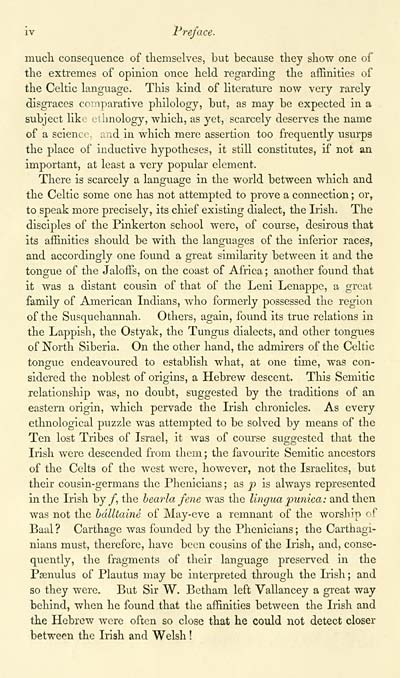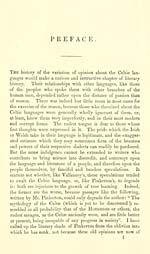Download files
Complete book:
Individual page:
Thumbnail gallery: Grid view | List view

iv Preface.
much consequence of tliemselves, but because they show one of
the extremes of opinion once held regarding the affinities of
the Celtic language. This kind of literature now very rarely
disgraces comparative philology, but, as may be expected in a
subject like ethnology, which, as yet, scarcely deserves the name
of a science, atid in which mere assertion too frequently usurps
the place of inductive hypotheses, it still constitutes, if not an
important, at least a very popular element.
There is scarcely a language in the world between which and
the Celtic some one has not attempted to prove a connection ; or,
to speak more precisely, its chief existing dialect, the Irish. The
disciples of the Pinkerton school were, of course, desirous that
its affinities should be with the languages of the inferior races,
and accordingly one found a great similarity between it and the
tongue of the Jaloffs, on the coast of Africa ; another found that
it was a distant cousin of that of the Leni Lenappe, a great
family of American Indians, who formerly possessed the region
of the Susquehannah. Others, again, found its true relations in
the Lappish, the Ostyak, the Tungus dialects, and other tongues
of North Siberia. On the other hand, the admirers of the Celtic
tongue endeavoured to establish what, at one tune, was con-
sidered the noblest of origins, a Hebrew descent. This Semitic
relationship was, no doubt, suggested by the traditions of an
eastern origin, which pervade the Irish chronicles. As every
ethnological puzzle was attempted to be solved by means of the
Ten lost Tribes of Israel, it was of course suggested that the
Irish were descended from them ; the favourite Semitic ancestors
of the Celts of the west were, however, not the Israelites, but
their cousin-germans the Phenicians ; as p is always represented
in the Irish by/, the hearla fene was the lingua punica: and then
was not the hdlltaine of May-eve a remnant of the worship of
Baal ? Carthage was founded by the Phenicians ; the Carthagi-
nians must, therefore, have been cousins of the Irish, and, conse-
quently, the fragments of their language preserved in the
Pgenulus of Plautus may be interpreted through the Irish ; and
so they were. But Sir W. Bctham left Vallancey a great way
behind, when he found that the affinities between the Irish and
the Hebrew were often so close that he could not detect closer
between the Irish and Welsh !
much consequence of tliemselves, but because they show one of
the extremes of opinion once held regarding the affinities of
the Celtic language. This kind of literature now very rarely
disgraces comparative philology, but, as may be expected in a
subject like ethnology, which, as yet, scarcely deserves the name
of a science, atid in which mere assertion too frequently usurps
the place of inductive hypotheses, it still constitutes, if not an
important, at least a very popular element.
There is scarcely a language in the world between which and
the Celtic some one has not attempted to prove a connection ; or,
to speak more precisely, its chief existing dialect, the Irish. The
disciples of the Pinkerton school were, of course, desirous that
its affinities should be with the languages of the inferior races,
and accordingly one found a great similarity between it and the
tongue of the Jaloffs, on the coast of Africa ; another found that
it was a distant cousin of that of the Leni Lenappe, a great
family of American Indians, who formerly possessed the region
of the Susquehannah. Others, again, found its true relations in
the Lappish, the Ostyak, the Tungus dialects, and other tongues
of North Siberia. On the other hand, the admirers of the Celtic
tongue endeavoured to establish what, at one tune, was con-
sidered the noblest of origins, a Hebrew descent. This Semitic
relationship was, no doubt, suggested by the traditions of an
eastern origin, which pervade the Irish chronicles. As every
ethnological puzzle was attempted to be solved by means of the
Ten lost Tribes of Israel, it was of course suggested that the
Irish were descended from them ; the favourite Semitic ancestors
of the Celts of the west were, however, not the Israelites, but
their cousin-germans the Phenicians ; as p is always represented
in the Irish by/, the hearla fene was the lingua punica: and then
was not the hdlltaine of May-eve a remnant of the worship of
Baal ? Carthage was founded by the Phenicians ; the Carthagi-
nians must, therefore, have been cousins of the Irish, and, conse-
quently, the fragments of their language preserved in the
Pgenulus of Plautus may be interpreted through the Irish ; and
so they were. But Sir W. Bctham left Vallancey a great way
behind, when he found that the affinities between the Irish and
the Hebrew were often so close that he could not detect closer
between the Irish and Welsh !
Set display mode to: Large image | Transcription
Images and transcriptions on this page, including medium image downloads, may be used under the Creative Commons Attribution 4.0 International Licence unless otherwise stated. ![]()
| Early Gaelic Book Collections > Blair Collection > Celtic studies > (8) |
|---|
| Permanent URL | https://digital.nls.uk/75771270 |
|---|
| Description | A selection of books from a collection of more than 500 titles, mostly on religious and literary topics. Also includes some material dealing with other Celtic languages and societies. Collection created towards the end of the 19th century by Lady Evelyn Stewart Murray. |
|---|
| Description | Selected items from five 'Special and Named Printed Collections'. Includes books in Gaelic and other Celtic languages, works about the Gaels, their languages, literature, culture and history. |
|---|

